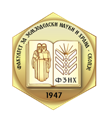QUANTITATIVE PREDICTION OF TOMATO IRRIGATION NEEDS USING CROPWAT MODEL
Keywords:
CROPWAT 8.0, Irrigation water requirement, Tomato, Greenhouse.Abstract
Emerging climate changes and rapidly growing demand for food are creating preconditions for making water an increasingly valuable resource and irrigation management assumed greater importance and increasingly responsible essential role. This study uses CROPWAT 8.0 model by FAO to predict and simulate crop water requirements for greenhouse tomato production in Chelopechene experimental field of the Institute of soil science, agrotechnologies and plant protection in Sofia, Bulgaria. The main input data are climatic data, crop data and soil data. The simulation results analysis suggests that an actual irrigation requirement of tomato is 489.5 mm. This study has proved that decision support tools like CROPWAT 8.0 are useful for irrigation planning and management and could be used by farmers to determine irrigation requirement and frequency, as well as contribute to saving water resources.



